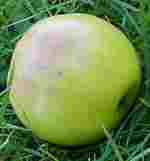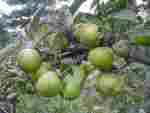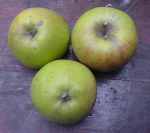
English Apples - MM106, rootstock apple
Most rootstocks, if allowed to fruit, produce apples with a bland taste and a texture of cotton wool. An exception is
MM106, which has good parentage.
This is an excellent late eating apple, maturing in late November and retaining its
crunchy and juicy texture, with good strong flavour, until well after the new year. It's ready to eat when it gets a brownish blush
on one side. They hang late, and should be picked when the first one or two start to fall - usually in late
November or early December. They mature about the same time as Allen's Everlasting or Annie Elizabeth, though it varies
a little from year to year. Being green, they don't attract the attention of birds too much.
MM106 is usually used as a rootstock, but I grow one tree just for its fruit. It is higher in vitamin C than
nearly all other
apples, which it retains for most of the
winter. It's surprising that no-one sells it as an apple in its own right.
It's a cross from the East Malling
Research Station (1932) of Northern Spy (a dessert apple) with English Broadleaf - another rootstock.
There is no common name for it. (Emma-Jane Lamont of Brogdale told me the genealogy ; many thanks)
Unlike M9 and M26, which are small golf-ball size, smooth and yellow, MM106 is quite large and green, ripening to greenish-
brown on the sunny side. Some apples are partially covered with russet or netted, usually in a single patch. They store well; in some years
they are still good in early May.
Pictures (click on small images for detail):
Blossom

Fruit
 ......
......
 ......
......
 ......
......
compiled by Nigel Deacon / Diversity website